Menu
- Books
- Collections
- Anthologies
- Selected Proceedings
- Special numbers
- Articles and chapters
- Reviews - academic and professional
- Reviews - popular
- Technical reports
- Miscellanies
Books—Trades and monographs
 Figures and Constructions. Forthcoming (2026). Cambridge: Cambridge University Press.
Figures and Constructions. Forthcoming (2026). Cambridge: Cambridge University Press.
Rhetorical Figures and Grammatical Constructions are linguistic patterns studied in parallel traditions of the Communication Sciences. They have very significant overlaps and crucial differences. Most importantly, they both align form and function. But figures align form and function by leveraging iconicity. Constructions align them by leveraging convention. Figures appeal to neurocognitive perceptual and categorization biases (similarity, correlation, proximity, repetition, …) to give expressions salience and memorability. They are engines of innovation and change in language, associated with poetry and extravagance. Constructions appeal to direct communicative demands (clarity, conformity, economy). They are engines of stability, clarity, and social identity.
This book will chart a research programme that brings constructions and figures together, advancing both Rhetoric and Linguistics.
(P.S. The book cover image is just a placeholder; I poached it from Adobe’s templates.)

Voice interaction design. 2005. San Francisco: Morgan Kaufmann Publishers (an Elsevier imprint).
"This is that rare book in Human Computer Interaction we all hope for: the presentation of a practical design process for an emerging important area that is carefully developed out of supporting science. Harris's book offers a competitive edge for designers and a provocative framing of problems for researchers in language." —Stuart Card, PARC.
Soundly anchored in HCI, cognitive psychology, linguistics, and social psychology, this supremely practical book is loaded with examples, how-to advice, and design templates. —ACM Digital Library
Download the excerpt featured in ACM's Ubiquity.
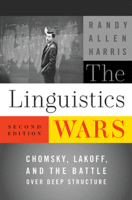 The linguistics wars. 1993. Second edition 2021. New York: Oxford University Press.
The linguistics wars. 1993. Second edition 2021. New York: Oxford University Press.
"an extremely engaging account of the rise of generative syntax and of some of the linguists who participated in this development, focusing on the scruffy fights that held a lot of people’s attention in the second half of the 1960s, ...[Harris] is a terrific writer, the likes of which we rarely see among academics" John Goldsmith, History and Philosophy of the Language Sciences.
"Randy Harris has done the intellectual world a remarkable service by displaying in detail the battles that defined the field of “theoretical linguistics” for many years." Geoffrey Sampson, lingbuzz/006550.
"Linguists, whatever your persuasion, please read this book. Seriously, it's hard to understand the current field without knowing this history. It's unbiased (no one is immune), accurate, and most importantly, entertaining." https://t.co/NNvK5xxGxW — Adele Goldberg (@adelegoldberg1) November 2, 2021
Harris ... demonstrates a deep knowledge of the issues in the conflict; he also brings a needed sense of perspective to the story. His stunning bibliography runs a monograph-length 65 pages, with over 1600 entries, and he appears to have absorbed it all. —Andy Rogers, LINGUIST
“As an attempt to bring the discipline to life the way James D. Watson brought DNA research to life in The Double Helix, it is a complete success. ... This is intellectual history crossed with a Shakespearean history play.”—David Berreby, The Sciences.
"...outstanding ... meticulous detail ... great sensitivity and unswerving impartiality ... Harris has achieved the near impossible: being fair to both sides in a civil war." —Neil Smith, Nature
"brilliantly comprehensive in its grasp of historical fact and conceptual detail, and engagingly written to boot." —Geoffrey Galt Hapham, Salmagundi
"[T]he book is extraordinarily well written ... not only broad but also deep ... refreshing ... the standard of scholarship exemplified in the book is simply stunning. —John Lawler, LINGUIST
 Acoustic dimensions of functor comprehension in Broca's aphasia. 1988. Bloomington: Indiana University Linguistics Club.
Acoustic dimensions of functor comprehension in Broca's aphasia. 1988. Bloomington: Indiana University Linguistics Club.
"In a replication of Heilman and Scholes' principal results, it was found that the aphasic population was significantly less reliable overall than normals in a forced choice task and that the difference between correct responses and function errors was not significantly greater than chance for sentences with normal intonation. However, a salient effect was discovered, in that the subjects were significantly more reliable with acoustically boosted tokens of the key function word. Harris suggests that there is a performance component to Broca syndrome functor difficulties and offers an explanation of the results in terms of short term memory difficulties. The work includes a literature survey more comprehensive than any to date in this area. Mr. Harris' book will find interested readership from the fields of both linguistics and communicative disorders." —IULC catalogue.
Books—Collections
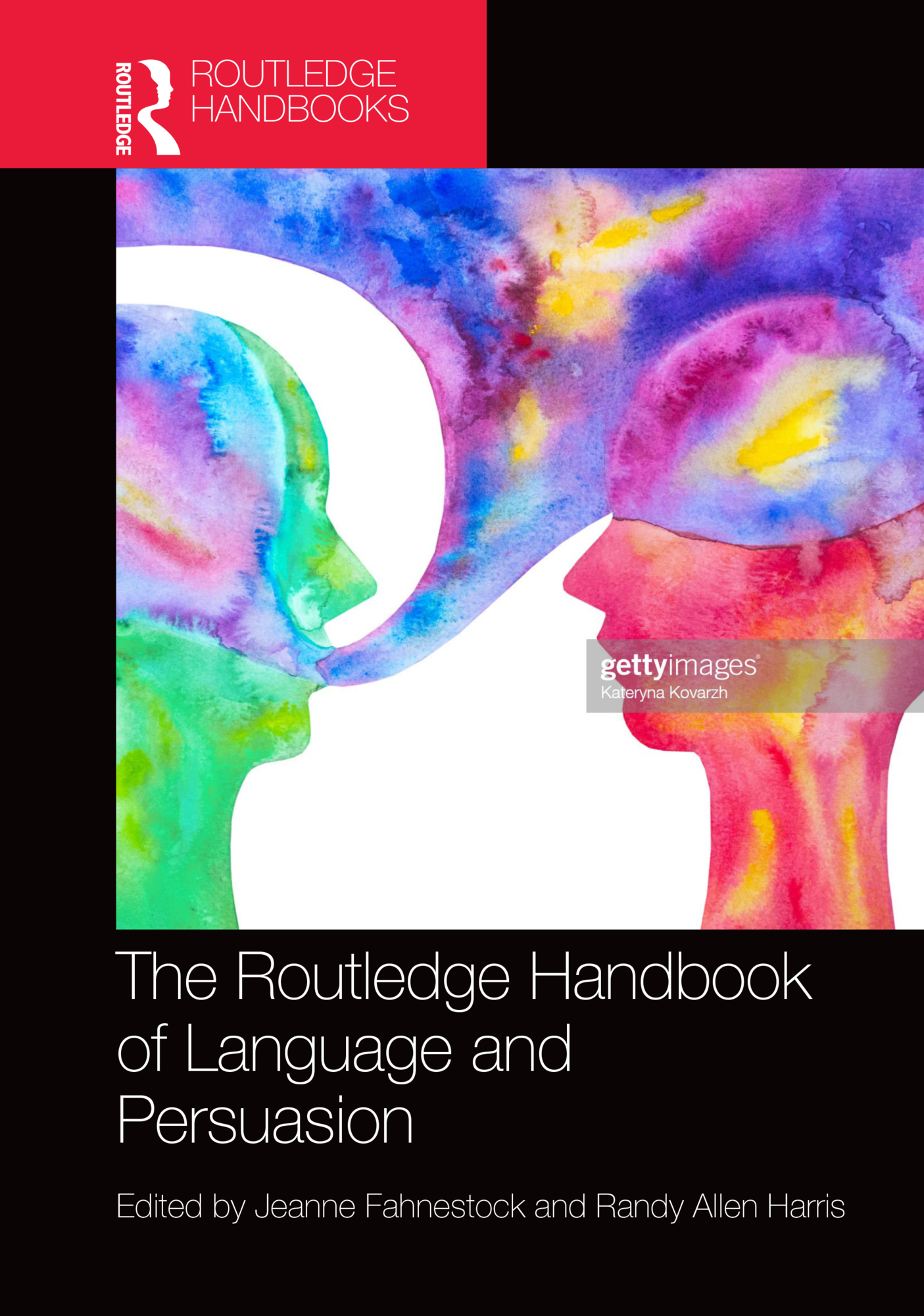 Routledge handbook of language and persuasion. 2023. Edited with Jeanne Fahnestock. Routledge.
Routledge handbook of language and persuasion. 2023. Edited with Jeanne Fahnestock. Routledge.
Featuring an introduction by Fahnestock and me and individual chapters by each of us, and chapters by Michael Billig & Cristina Marinho, Bryan Blankfield, Martin Camper, Davida Charney, Martha Cheng, William Donohue & Mark Hamilton, Sara Greco & Anne-Nelly Perret-Clermont, Alan G. Gross, Mansup Heo, Chris Holcomb & Heather Buzbee, Cornelia Ilie, James Jasinski, David Kaufer & Suguru Ishizaki, Gabrijela Kišiček, John Lawrence & Jacky Visser, Jennifer Lin LeMesurier, Daniel Libertz, Ashley Rose Mehlenbacher, Cameron Mozafari, Sisanda Nkoala, Todd Oakley, John Oddo, Alex Parrish, Penny M. Pexman, Christopher Tindale, Steve Wilcox, James Wynn, and Ying Yuan.
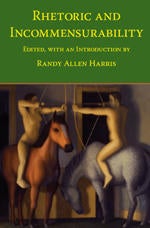 Rhetoric and incommensurability. 2005. Parlor Press.
Rhetoric and incommensurability. 2005. Parlor Press.
Featuring an introduction by me; and with chapters by Charles Bazerman and René Agustín De los Santos; John Angus Campbell; Leah Ceccarelli; Jeanne Fahnestock; Alan G. Gross; Paul Hoyningen-Huene; Thomas Lessl; John Lyne; Carolyn R. Miller; Lawrence Prelli; and Herbert W. Simons.
"Harris’s booklength introduction ... impresses me as a real tour de force. The book is worth buying for this essay alone for the revealing way it disentangles themes in the literature on incommensurability, including discussion of rhetoric and ways of dealing with incommensurability." —Struan Jacobs, International Studies in the Philosophy of Science
"Not only is Harris’s ‘‘Introduction’’ theoretically sound, it is also written with a wit and humor that thoroughly engages the reader. I admit I found myself laughing out loud on more than one occasion." —S. Scott Graham, Rhetoric Society Quarterly
"Rhetoric and Incommensurability should attract attention from almost anyone interested in rhetoric. The incommensurability issue has implications that encompass all flavors of rhetoric, and the book seems well designed both to engage the rhetoric of science specialists and the more general audience of rhetoricians." —Michael C. Leff (prepublication)
"[This book] will be of interest to rhetoricians, students of scientific rhetoric, and a range of scholars in various arenas of science studies. It will also be of interest to philosophers of science, and to philosophers interested in rhetoric." —Harvey Siegel (prepublication)
Books—Anthologies
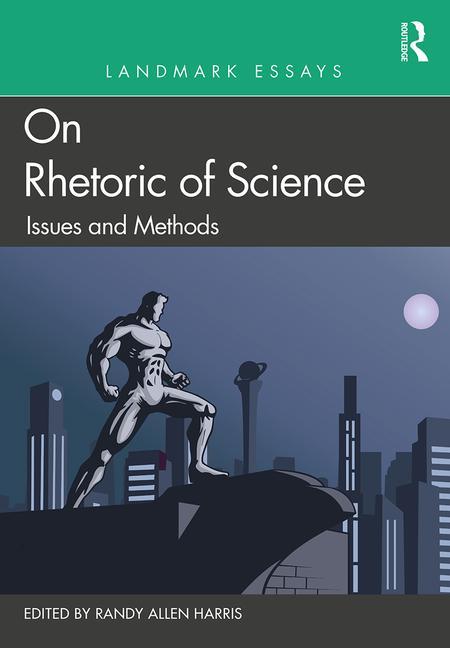 Landmark essays in rhetoric of science: Issues and methods. 2020. London: Routledge.
Landmark essays in rhetoric of science: Issues and methods. 2020. London: Routledge.
Featuring an introduction by me; and with reprinted essays by Charles Sanders Peirce; P. N. Campbell; Philip C. Wander; Herbert W. Simons; Leah Ceccarelli; J. E. McGuire & Trevor Melia; James H. Collier; David J. Depew & John Lyne; Nathan Crick; Kenneth S. Zagacki & William Keith; Carolyn R. Miller; Jeanne Fahnestock; Gordon R. Mitchell; Lynda Walsh (now Olman) & Kenneth C. Walker; Xiaosui Xiao; Celeste M. Condit; Craig O. Stewart; Ashley Rose Mehlenbacher & Kate Maddalena; and two essays by Alan G. Gross.
"[I]nvaluable for graduate students and scholars new to the area ... extremely valuable history" (David Gruber, POROI).
"Harris’s comprehensive grasp of the rhetoric of science literature is impressive ... [He] is unmistakably a storyteller. But he is also a cartographer, charting, in detail, the bumpy rhetoric of science terrain for future travelers" (Alexander William Morales, Social Epistemology)
 Landmark essays in rhetoric of science: Case studies. 1997. Second edition, 2018 (Routledge). Mahwah, NJ: Hermagoras Press (a Lawrence Erlbaum Associates imprint).
Landmark essays in rhetoric of science: Case studies. 1997. Second edition, 2018 (Routledge). Mahwah, NJ: Hermagoras Press (a Lawrence Erlbaum Associates imprint).
Featuring an introduction by me; and with reprinted essays by Charles Bazerman; John Angus Campbell; Leah Ceccarelli; Jeanne Fahnestock; Alan G. Gross; S. Michael Halloran; John Lyne & Henry Howe; Ashley Rose Kelly [now Mehlenbacher] & Carolyn R. Mille;, Greg Myers; Lawrence Prelli; Carol Reeves; Michelle Sidler; Richard M. Weaver; Craig Waddell; and James Wynn; and with a bibliography by me [deleted for the second edition]
"Randy Allen Harris has brilliantly sketched into place the origins and history of the field" (Jeanne Fahnestock, Techical Communication Quarterly)
“Harris’s introduction is an illuminating and witty presentation of the kinds of assumptions lay readers make about why scientists try to appeal to the public, and why scientific methods themselves can be considered instruments of persuasion. … Together the case essays and Harris’s introductory conversation challenge the reader to ask: If the scientist in question is attempting to introduce new evidence, what will it take to persuade other scientists of its validity. Or is any science, any experimentation, or system of validity an attempt to persuade any public, scientific or popular, to believe in a model of reality? What makes this collection vital is that it addresses these questions through specific landmark cases and, in the process, reveals the impact of having asked them.”—Rebecca Hettich, Technical Communication.
"Ultimately, both volumes of Landmark Essays offer profound insights not just about rhetoric of science, but the rhetorical studies field in general. The essays included in these books offer profound insights about the nature of rhetoric and I encourage rhetorical scholars of all types to consider exploring these works. Rhetoric of science is a field constantly evolving, and Harris’s anthologies serve as invaluable resources for anyone interested in continuing this area of inquiry. " —Alexander William Morales, Social Epistemology
See Alexander William Morales's "An X too far" in the Social Epistemology Review and Reply Collective, my reply, "X marks the spot," and if you want to keep going, Morales's reply to my reply, "Why didn’t I pick a fight about X?: An inquisitive response to Harris;” as well as the tandem reviews by David Gruber and Pamela Pietrucci in POROI, "Where Did the Rhetoric of Science Go?," and yet more from me, responding again to Morales and also to the Gruber and Pietrucci reviews, Everybody stands ready for eXcetera: Rhetoric of science meets the Pickwick Papers; or A humble reply to Morales (and Gruber and Pietrucci); as you may have realized by now, the mushrooming exchange turned into something of a colloquy about rhetoric of science, as a practice and a discipline.
Proceedings
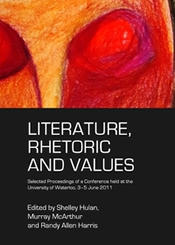 Literature, Rhetoric, and Values. Edited with Shelley Hulan and Murray McArthur. 2012. Cambridge, UK: Cambridge Scholars Press.
Literature, Rhetoric, and Values. Edited with Shelley Hulan and Murray McArthur. 2012. Cambridge, UK: Cambridge Scholars Press.
A selection of essays developed out of the Literature, Rhetoric and Values Conference held at the University of Waterloo in 2011, commemorating the 50th year of the English department.
The essays in this collection combine cutting-edge literary and rhetorical scholarship to investigate the evolving values of the modern world, confronting such issues as torture, genocide, environmental apocalypse, and post-traumatic stress syndrome. First delivered as part of the vibrant ideas exchange of an international conference, they are the product of rigorous selection and review undertaken with an emphasis on their complementarity.
The authors include established scholars such as groundbreaking genre-theorist Carolyn R. Miller, phenomenological rhetorician and cultural critic Michael MacDonald, and eco-critic Andrew McMurry, alongside an exciting company of emerging voices. Together, they essay the ethical and cultural dimensions of ‘works’ ranging from whiskey bottles and microblogs to graphic novels and classified government documents, as well as more established forms of poetry and fiction. An introduction by the editors frames the rhetorical and literary critical backdrop to these studies, summarizes their individual contributions, and sets them in relation to each other and the guiding themes of the conference.
Check out the introduction and table of contents (pdf). Review by Jennifer R. Ballengee, in Present Tense 1.4.
Special numbers
- Constructions and figures. Forthcoming [2027]. Edited with Bracha Nir. A special number of Constructions and Frames.
-
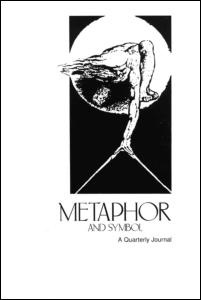 Rhetorical figures. Edited with Crysanne Di Marco. 2017. A special number of Argument & Computation (8.3). With an introduction by me and Chrysanne Di Marco, including a glossary of rhetorical terms; and articles by Ashley Rose Mehlenbacher; Ying Yuan; Jelena Mitrović, Cliff O’Reilly, Miljana Mladenović, & Siegfried Handschuh; and John Lawrence, Jacky Visser, & Chris Reed.
Rhetorical figures. Edited with Crysanne Di Marco. 2017. A special number of Argument & Computation (8.3). With an introduction by me and Chrysanne Di Marco, including a glossary of rhetorical terms; and articles by Ashley Rose Mehlenbacher; Ying Yuan; Jelena Mitrović, Cliff O’Reilly, Miljana Mladenović, & Siegfried Handschuh; and John Lawrence, Jacky Visser, & Chris Reed.
- Cognitive allegory. Edited with Sarah Tolmie. 2011. A special number of Metaphor and Symbol (26.2). With an introduction by me and Sarah Tolmie; with articles by Paul Thagard, Raymond W. Gibbs, Jr., Todd Oakley with Peter Crisp, and Madeleine Kasten with Curtis Gruenler.
- Rhetoric of science in Canada. Edited with Isabelle Clerc and Zelie Gueval. 2000. A special number of Technostyle (16.1). With an introduction by me, Zélie Guéval, and Isabelle Clerc; with articles by Céline Beaudet; Ginette Demers, Isabelle Collombat, Sylvain Jobin & Valérie Richard; Bruno Latour & Paolo Fabbri (with a translation by Sarah Cummins); Joyce Parsons; Frances Ranger; Christine Trott; and Judy Segal; and with a note by Michael Overington.
- Technical communication in Canada. Edited with Pamela Russell. 1994. A special number of The Journal of Technical Writing and Communication (24.3). With an introduction by me and Pamela Russell; with articles by Jacqueline Bossé-Andrieu, Hélène Cajolet-Laganière & Pamela Russell; Jennifer J. Connor; Dave Goodwin; Roger Graves, Jack McFadden & Shirley Moore; Michael P. Jordan; Lilita Rodman; and Candace Séguinot; and with a bibliography by Jennifer J. Connor.
Articles and chapters
- Rhetorical schemes and Construction Grammar: The argument from chiasmus. 2026. Constructions and Frames.
- Rhetorical figures, Grammatical Constructions, and form/meaning alliances in Pretrained Language Models. Forthcoming [2026]. With Kavi Duvvoori (senior author). POROI.
- Ethos management in political marketing videos. Forthcoming [2026]. With Monique Kampherm (senior author). Political Marketing in a Canadian Election. Edited by Alex Marland, Thierry Giasson and Elizabeth Dubois. Vancouver: UBC Press.
- Define constructions before constructions define you: Rhetorical figures in the AB before BA construction. With Romina Hashemi (senior author) and Huini Chen. 2024. Rhetor 9 11-63.
- Sex after technology: The rhetoric of health monitoring apps and the reversal of Roe vs. Wade. 2024. With Kem-Laurin Lubin (senior author). Rhetoric Society Quarterly 54:3, special issue on Rhetoric of/with Artificial Intelligence, S. Scott Graham and Zoltan P. Majdik, editors, 247-262.
- Rules are rules: Rhetorical figures as algorithms. 2023. In Logic and algorithms in computational linguistics (Studies in computational intelligence series). Edited by Roussanka Loukanova, Peter LeFanu Lumsdaine, and Reinhard Muskens. Springer.
- The tropes: Metaphor and its friends. 2023. Routledge handbook of language and persuasion. Edited by Jeanne D. Fahnestock and me. Routledge, 227-245.
- Rhetoric, Linguistics, and the Study of Persuasion: An Overview and an Introduction. 2023. With Jeanne D. Fahnestock. Routledge handbook of language and persuasion. Edited by Jeanne D. Fahnestock and me. Routledge Handbooks in Linguistics series. Routledge, 1-24.
- Grammatical constructions and rhetorical figures: The case of chiasmus. 2022. LACUS Forum 46.1, 35-61.
- Chiastic iconicity: Refiguring symmetry. 2022. Iconicity in cognition and across semiotic systems. Iconicity in Language and Literature 18. Edited by Sara Lenninger, Olga Fischer, Christina Ljungberg, and. Elzbieta Tabakowska (Amsterdam: John Benjamins), 103-134.
- Beauty and truth, truth and beauty: Chiastic structure increases the subjective accuracy of statements. 2022. With Mane Kara-Yakoubian [Senior author], Alexander C. Walker, Konstantyn Sharpinskyi, Garni Assadourian, and Jonathan A. Fugelsang. Canadian Journal of Experimental Psychology / Revue canadienne de psychologie expérimentale.
- Jagmeet's kairotic challenge: Darkface, turbans, and hypocrisy upwards. 2021. Rhetoric, Politics, and Culture 1.2: 171–204.
- The cognitive and computational programme in rhetorical studies. 2021. Rhetor 7.2.1:30-39.
-
Ploke. 2020. Metaphor & Symbol 35, 01: 23-42. DOI: 10.1080/10926488.2020.1712781
Translated into Chinese (2022), as 叠辞 by 陶友兰 (Tao Youlan) and 李逸竹 (Li Yizhu) for the journal,《当代修辞学》[Contemporary Rhetoric] 22.1. The translation was then also reprinted: https://mp.weixin.qq.com/s/dyIRcUvHJ_OkVVpl15jk9A - Dementia, rhetorical schemes, and cognitive resilience. 2020. POROI 15.1, Article 12.
- Introduction. 2020. Landmark essays onrhetoric of science: Issues and methods. Routledge.
- An ontological approach to meaning making through PATH and Gestalt foregrounding in climax. 2019. With Lillian A. Black [Senior author], Katherine Tu, Cliff O’Reilly, Yetian Wang, & Paulo Pacheco. The American Journal of Semiotics 35.1-2.
- The fourth master trope, antithesis. 2019. Advances in the History of Rhetoric 22.1.
- Scientific futures for a rhetoric of science: We do this and they do that? With David R. Gruber [Senior author]. 2018. POROI 14.2, Article 2.
- An annotation scheme for rhetorical figures. With Chrysanne Di Marco, Sebastian Ruan, and Cliff O'Reilly. 2018. Argument & Computation 9.2:155-175.
- Introduction. 2018. Landmark Essays on Rhetoric of Science: Case Studies. Second edition. Routledge.
- Stasis salience and the enthymemic thesis. With Ying Yuan [Senior author] and Yan Jiang. 2017. Language and Semiotic Studies 3.3:103-124.
- Rhetorical figures, arguments, computation. With Chrysanne Di Marco. 2017. Argument & Computation 8.3: 211-231.
- A figurative mind: Gertrude Buck's The Metaphor as a nexus in cognitive metaphor theory. With Ashley Rose Mehlenbacher [Senior author]. 2017. Rhetorica. 35.1:75-109.
- Argumentative meanings and their stylistic configurations in clinical research publications.With Olga Gladkova[Senior author] and Chrysanne Di Marco. 2016. Argument & Computation 6.3:310-346.
- Alan G. Gross: Floppy-eared rhetorical rabbit, redux. 2014. POROI 10.2
- What's in a name? Journal titles in the field of epistemic research. With Olga Gladkova [Senior author] and Chrysanne Di Marco. 2014. The Journal of Argumentation in Context. 3.3
- Figural logic in Mendel's Experiments on plant hybrids. 2013. Philosophy and Rhetoric 46.4
-
The rhetoric of science meets the science of rhetoric. 2013. POROI 9.1.
Reprinted in POROI 19.1, The 25th Anniversary issue, as one of "most influential articles published in the first 25 years of the journal." - Introduction, Literature, rhetoric, and values. With Shelley Hulan and Murray McArthur. 2012. Cambridge, UK: Cambridge Scholars Press: 1-12.
- Cognitive allegory: An introduction. With Sarah Tolmie. 2011. Metaphor & Symbol 26.2.
- Scheme trope chroma chengyu: Figuration in Chinese four-character idioms. With Lynn Chien [Senior author]. 2011. Cognitive Semiotics 6: 155-178.
- Chomsky’s other revolution. 2010. In Chomskyan revolutions/evolutions. Edited by Douglas Kibbee. Philadelphia: John Benjamins, 237-264.
- Alan Gross and the rhetoric of science. 2009. Perspectives on Science 17.3.
- Keeping curious company: Wayne C. Booth's friendship model of criticism and the work of Hunter S. Thompson. With Stefanie Stiles [Senior author]. 2009. College English 71.4, 309-333.
- Generative Semantics. 2010. Article by James D. McCawley with a forward by me. [McCawley's original article appeared in 1994; he passed away in 1999 and I was asked to revise it for a second edition and I chose rather to write a forward]. In Keith Allan, editor. Concise encyclopedia of semantics. Second edition. (Amsterdam: Elsevier), pp.67– 71.
- Reception studies in rhetoric of science. 2004. Technical Communication Quarterly 14.3, 249-255.
- Knowing, rhetoric, science. 2002. Visions and revisions: Issues in rhetoric and composition. James Williams, ed. Carbondale: Southern Illinois University Press, 163-219.
- Other words. 1999. And no birds sing: Rhetorical analyses of Rachel Carson's Silent spring. Craig Waddell, ed. Carbondale: Southern Illinois University Press, 126-156.
- A note on the Max Planck Effect. 1998. Rhetoric Society Quarterly 28, 85-9.
- Rhetoric of science in Canada. With Isabelle Clerc and Zélie Guéval. 1995. Technostyle 16.1:11-21.
- Technical communication in Canada; La communication technique au Canada. With Pamela Russell. 1994. The Journal of Technical Writing and Communication 24.3:221-36.
- The Chomskyan revolution 1: Science, syntax, and semantics. 1994. Perspectives on Science 2, 38-75.
- The Chomskyan revolution 2: Sturm und Drang. 1994. Perspectives on Science 2, 176-230.
- Generative semantics: Secret handshakes, anarchy notes, and the implosion of ethos. 1993. Rhetoric Review 23, 125-60.
- The origin and development of generative semantics. 1993. Historiographia Linguistica 20.2/3, 397-439.
- Posterity as exigence: Arthur Inman and his audience. 1992. Rhetoric Society Quarterly 22.2, 51-65 (Special Issue on Chaim Perelman).
- A do-it yourself usability kit. 1991. The Journal of Technical Writing and Communication 21.4, 351-68. Reprinted [for a workshop] in the Proceedings of the Third Conference on Quality in Documentation: Usability Concepts and Procedures. 1992. Won a Society of Technical Communication Award of Merit "for exceptional achievement in technical communication."
- Rhetoric of science. 1991. College English 53.3, 282-307.
- Social definition in Pride and Prejudice: An exercise in extensional semantics. 1991. English Studies in Canada17.2, 163-76.
- A taxonomy of online information. With William Hosier. 1991. Technical Communication 38.2, 197-210.
- Assent, dissent, and rhetoric in science. 1990. Rhetoric Society Quarterly 20.1, 13-37. Reprinted in Humanistic aspects of technical communication (Paul Dombrowski, editor; Baywood, 1994), and in Teaching Argument in the Composition Course: Background Readings (Timothy Barnett, editor; Bedford/St.Martin's Press, 2002).
- Linguistic guidelines for graphic interfaces. 1990. IEEE Transactions on Professional Communication 33.1, 46-53. Abstracted by Amy Dassie for an article in Stimulus 18.1:1-4 (1991), the newsletter of the Eastern Ontario chapter of the Society for Technical Communication.
- Argumentation in Syntactic Structures: An exercise in the rhetoric of science. 1989. Rhetoric Society Quarterly 19.2, 105-30.
- A signal-processing component to Broca's aphasia. With Lois Marckworth Stanford and Thomas F. Campbell. 1989. Neuropsychologia 27.5, 599-605.
- The man who was a thing: Criticism and Uncle Tom's cabin. 1988. College English 50.6, 37-51. This paper won a McKinney Graduate Academic Essay Prize (RPI).
- Ethos and the power of Syntactic structures. 1989. In Rhetoric and ideology: Compositions and criticisms of power. Charles W. Kneupper, editor. Arlington: Rhetoric Society of America, 189-96.
- Linguistics, technical writing, and generalized phrase structure grammar. 1988. The Journal of Technical Writing and Communication 18.3, 227-40. This paper won The Jay Gould Award for Excellence in Technical Writing, and also engendered a minor controversy (see Ferguson and Parker, "Grammar and Technical Writing," also JTWC 20, pp. 357-68, 1990, and my response two volumes later, JTWC 22, pp.53-6, 1992).
- Bakhtin, Phaedrus, and the geometry of rhetoric. 1988. Rhetoric Review 18.1:168-76. Won a McKinney Graduate Academic Essay Prize (RPI), and was reprinted in Frank Farmer, ed. Landmark essays on Bakhtin. Mahwah, NJ: Lawrence Erlbaum, 15-22.
Reviews — academic and professional
- [A much longer version of the LINGUIST review I did of this book, because of LINGUIST's word-count constraints] María Sandra Peña-Cervel and Francisco José Ruiz de Mendoza Ibáñez's Figuring out figuration: A cognitive linguistic account (Philadelphia: John Benjamins, 2022). lingbuzz/0076213 October 2023.
- María Sandra Peña-Cervel and Francisco José Ruiz de Mendoza Ibáñez's Figuring out figuration: A cognitive linguistic account (Philadelphia: John Benjamins, 2022). LINGUIST 34.1566.
- John Goldsmith and Bernard Laks's Battle in the mindfields (Chicago: Chicago University Press, 2019). Language 97.1: 194-200.
- James McElvenny's Form and formalism in linguistics (History and philosophy of the language sciences 1). (Berlin: Language Science Press, 2019.) Language & History. DOI: 10.1080/17597536.2020.1744267
- Mihailo Antović and Cristóbal Pagán Cánovas's Oral poetics and cognitive science (Berlin: De Gruyter, 2016). H-Rhetor 17 February 19.
- Armin Burkhardt and Brigitte Nerlich’s Tropical truth(s): The epistemology of metaphor and other tropes (Berlin: Walter de Gruyter, 2010). Quarterly Journal of Speech 97.4, 473-477.
- Deanna D. Sellnow's The rhetorical power of popular culture: Considering mediated texts (Thousand Oaks, CA: SAGE, 2009). Rhetoric Society Quarterly 40.3, 298-302.
- Christine L. Borgman's Scholarship in the digital age: Information, infrastructure, and the internet (Cambridge, MA: The MIT Press, 2007). Technical Communication 56 (2009), 189-191.
- Laila Dybkjaer and Wolgang Minker's Recent trends in discourse and dialogue (Dordrecht: Springer, 2008). Technical Communication 55.4. 2008, 426.
- Philip B. Meggs's History of graphic design, 4th Edition (revised by Alston W. Purvis). (New York: John Wiley & Sons, 2005). Technical Communication 54. 2007, 359-385.
- Roy Harris's Semantics of science (New York: Continuum Press, 2005). 2007. Language in Society 36, 802-805.
- Clifford Nass and Scott Brave's Wired for speech: How voice activates and advances the human-computer relationship (Cambridge, MA: The MIT PRess, 2005). 2006. Technical Communication 53, 471-492.
- Fang Chen's Designing human interface in speech technology (New York: Springer, 2006). Unpublished (commissioned by Technical Communication, but the book was so disgracefully edited that there was little positive I could say, and the editor, rightly I think, decided not to run it).
- Robert Bringhurst's The elements of typographic style, version 3.0 (Point Roberts, WA: Hartley & Marks, 2004). 2005. Technical Communication 52, 476-77.
- Michael H. Cohen, James P. Giangola, and Jennifer Balogh's Voice user interface design (Boston, MA: Addison Wesley, 2004). 2005. Technical Communication 52, 476.
- Asaf Degani's Taming HAL: designing human interfaces (New York: Palgrave Macmillan, 2004). 2005. Technical Communication 52, 476-77.
- John Angus Campbell and Stephen C. Meyer's Darwinism, design, and public education (East Lansing, MI: Michigan State University Press, 2003). 2004. Rhetoric Society Quarterly.
- Leah Ceccarelli's Shaping science with rhetoric: the cases of Dobzhansky, Schrödinger, and Wilson (Chicago: University of Chicago Press, 2001). 2003. Review of Communication.
- Richard Marback's Plato's dream of sophistry (Carbondale, IL: Southern Illinois University Press, 1999). Unpublished (Two separate book-review editors for Philosophy and rhetoric were set to publish it, until they read it. I think maybe they thought I was too hard on the book, and perhaps on Plato as well.)
- Susan Weinschenk and Dean T. Barker´s Designing effective speech interfaces (New York: John Wiley & Sons, 2000). 2001. Technical Communication 48.2:218-222.
- Jeanne Fahnestock's Rhetorical figures in science (New York: Oxford U P, 1999). 2001. Rhetoric Society Quarterly 31.
- Charles Kostelnick and David D. Roberts's Designing visual language (Allyn & Bacon, 1998). 1999. Technostyle.
- Charles Alan Taylor's Defining science: A rhetoric of demarcation (University of Wisconsin Press, 1997). 1999. Argumentation.
- Karen Schriver's Dynamics in document design (John Wiley, 1996). 1998. The Journal of Technical Writing and Communication.
- Wout van Bekkum et al.'s The emergence of semantics in four linguistic traditions: Hebrew, Sanskrit, Greek, Arabic (John Benjamins, 1996). 1998. The journal of the history of the behavioral sciences.
- Jonathan Potter's Representing reality: Discourse, rhetoric, and social construction (Sage, 1996). 1998. Rhetoric Society Quarterly 28:87-90.
- Linda Fowler and Victor Stanwick's The GUI style guide (AP Professional, 1995). The Journal of Technical Writing and Communication.
- Tony Fernandez's Global interface design (AP Professional, 1996). Technical Communication Quarterly 5:202-6.
- Frederick J. Newmeyer's Generative linguistics: A historical perspective (Routledge, 1996). LINGUIST 7-1451.
- Richard McKeon's On knowing: The natural sciences (Chicago UP, 1995). 1996. Rhetoric Review.
- Marcello Pera's Discourses of science (Chicago UP, 1994). 1995. Rhetoric Review 14:207-13.
- Alexander George's (editor) Reflections on Chomsky (Basil Blackwell, 1989). 1991. Word 42:327-36.
- Alan G. Gross's The rhetoric of science (Harvard University Press, 1990). Rhetoric Society Quarterly 21.4:32-35. See Gross's Response to Harris in the same issue..
- Rhetoric of science meets the Nazis. 1989. Review of Robert Proctor's Racial hygiene (Harvard UP, 1988). Rhetoric Society Quarterly 19:66-7.
Reviews — popular
- Robert F. Barsky's Noam Chomsky: A life of dissent. Books in Canada 27.2 (March 98), 14-17
- Rod Mengham's On language. The Sphere (1994).
- Robert Proctor's Racial hygiene. The Ottawa citizen. (December 1989).
- Northrop Frye's Creation and recreation Our books now (4.1:3, 1981).
-
The Globe and Mail
- National Edition
- Stephen Pinker's The language instinct (18 June 94)
- William Safire's In love with Norma Loquendi (24 December 94)
- David Stern's Wittgenstein on mind and language (25 November 95)
- Metro Edition
- John Willinsky's Empire of words (2 February 95)
- Marcello Pera's Discourses of science (1 June 95)
Technical reports
- Productopia meets Q, and Portia too. 2000. Qjunction Technology.
- Q and Portia. 2000. Qjunction Technology.
- Natural language interface usability. 2000. Qjunction Technology. With Harry Logan, Andrew McMurry, and Glenn Stillar. As editor and principal author.
- Technical documentation—Online information guidelines. 1990. Northern Telecom and Bell-Northern Research. As editor and principal author. Chapters include a general "Introduction," "Categories of online information," "Developing online information," "Writing online information," "Presenting online information," and "Organizing online information." A glossary and a list of references is also included
- NT Signature user interface guidelines. 1989. With Miguel Planas (senior author), John Meads, and others. Northern Telecom and Bell-Northern Research. My principal responsibility was for the chapter, "Linguistic guidelines" (pp. 81-109), a later version of which was published in the I.E.E.E. transactions on professional communication (as above), but I worked extensively on all aspects of the guidelines, and contributed to the writing of several other chapters.
- Instructors' manual for Linguistics 382, Modern English Syntax. 1985. With Matthew S. Dryer. The Department of Linguistics, University of Alberta.
Editorials, notes, responses, complaints, unrefereed proceedings papers, and other miscellanies
- Reply to Andy Rogers review of The linguistics wars: Chomsky, Lakoff and the battle over deep structure (LINGUIST List 33.3261). 2023. lingbuzz/006975.
- Afterword. 2023. The Many Voices of Modern Physics by Joseph Harmon and Alan Gross, University of Pittsburgh Press.
- Everybody stands ready for eXcetera: Rhetoric of Science meets the Pickwick Papers; or A humble reply to Morales (and Gruber and Pietrucci). 2022. In three installments, in the Social Epistemology Review and Reply Collective.
- X marks the spot. 2021. A reply to Alexander William Morales's "An X too far," reviewing my two Landmark essays volumes, in the Social Epistemology Review and Reply Collective; Morales's response to my response is Why didn’t I pick a fight About X?.
- The history of a science: unreliable narrators and how science moves on [more of a headline than a title; I didn't choose it]. 2018. openDemocracy 9 May, part of an exchange that starts with an article by Chris Knight (Chomsky's choice), and includes commentaries by Frederick J. Newmeyer, Lev Ledivow, David Golumbia, Wolfgang Sperlich, Peter Jones, and a second one by Knight.
- Hello Wolfgang. 2018. openDemocracy 8 November, a response to an article by Wolgang Sperlich (The latter day critics of Noam Chomsky) accusing me of being part of an improbable gang dogpiling on Noam Chomsky.
- Foreword to Sarah Cummins (2007) translation of Dan Sperber's “Rudiments of Cognitive Rhetoric,” Rhetoric society quarterly, 37, 357-359.
-
Articles in the Cambridge encyclopedia of the language sciences. Patrick Colm Hogan, editor. London: Cambridge University Press, 2008. Entries on:
- Standard Theory and Extended Standard Theory
- Generative Semantics
- Voice Interaction Design
-
Biographical entries in the Biographical dictionary of Western linguistics, 1450-present. John Joseph and Pierre Swiggers, editors. London: Routledge, 2000. Entries on:
- Jerry Fodor
- Jerrod Katz
- James McCawley
- Paul Postal
- John Robert (Haj) Ross
- Letter to the editor on Black English, Globe and Mail (January, 1994), an otherwise unremarkable little note, except that it was pounced upon by Peter C. Emberley as an example of liberal daffiness, in his "Hot-button politics on campus", The Globe and Mail (27 July 96), and in the larger polemic that piece comes from, his Zero tolerance: Hot button politics in Canada's universities (Penguin Canada, 1996).
- A response to David Berreby's "Figures of speech" (on my Linguistics wars). 1994. In "Peer Review. " The sciences(May/June)
- The LINGUISTics Wars (author's response). 1993. LINGUIST List 4.654.
- A response to John Lawler's review of my Linguistics wars (LINGUIST List 4.644); see also the comments of Steven Murray (and again, here), Richard Wojeck, Douglas Kibee, Helen Dry, and Barbara Need; the book also came up for discussion as part of an exchange over Robert Barsky's A Life in dissent (see Feargal Murphy, and the response by Paul Postal and Geoffrey Pullum (and Pullum again), and Barsky's take on the issues).
- A Response to K. Scott Ferguson and Frank Parker's "Grammar and technical writing." 1992. The Journal of Technical Writing and Communication 22:53-6.
- The pragmatics of usability. With Paul Yee (as senior author). 1989. Technicom '89 proceedings. Ann Rockley, editor. Toronto: Technicom, 155-60
- Acoustic dimensions of functor comprehension in Broca's aphasia. With Lois Marckworth Stanford. 1985. Proceedings of the Western Conference on Linguistics. Eugene: The University of Oregon.
Bibliographies
- Rhetoric of science infography
- Speech user interface design infography
- With Michael Truscello. Rhetoric of science in 2002. 2003. Technical communication quarterly 12.4.
- With Michael Truscello. Rhetoric of science in 2001. 2002. Technical communication quarterly 11.4.
- Rhetoric of science in 2000. 2001. Technical communication quarterly 10.4.
- Rhetoric of science in 1999. 2000. Technical communication quarterly 9.4.
- Rhetoric of science in 1998. 1999. Technical communication quarterly 8.4.
- Rhetoric of science in 1997. 1998. Technical communication quarterly 7.4.
- Rhetoric of science in 1996. 1997. Technical communication quarterly 6.4.
- Rhetoric of science in 1995. 1996. Technical communication quarterly 5.4.
- Rhetoric of science in 1994. 1995. Technical communication quarterly 4.4.
- Rhetoric of science in 1993. 1994. Technical communication quarterly 3.4
